It is important for me to be accountable and transparent in my decision-making. I will describe my decision-making process for every vote I make as your City Councillor. While there are many legislative rules that govern decision-making and transparency, these five stand out for me: (or, just jump to the Votes)
|
Section 3 of the Municipal Government Act states:
Section 9.1 of the City of Summerside Code of Conduct: Members of Council must adhere to the following principles and provisions:
Guide to the Municipal Government Act Handbook
Section 27 of the Planning Act:
|
My 25 Votes
| Vote #25: 134 Greenwood Drive Monthly Council Meeting April 21, 2025 Meeting Package |
VOTED YES Resolution Carried 6-2 Meeting Video Table Summary of All Votes |
|
As a preliminary subdivision application, the land use presented by the applicant has already been approved as a permitted use. Further, as a preliminary subdivision plan, this is prior to the final subdivision plan. So, the approval process differs from rezoning applications as the land use already conforms to the use identified by the applicant. My rationale to be uploaded soon. |
|
| Vote #24: 530 Central Street Monthly Council Meeting April 21, 2025 Meeting Package |
VOTED YES Resolution Carried 8-0 Meeting Video Table Summary of All Votes |
|
As a preliminary subdivision application, the land use presented by the applicant has already been approved as a permitted use. Further, as a preliminary subdivision plan, this is prior to the final subdivision plan. So, the approval process differs from rezoning applications as the land use already conforms to the use identified by the applicant. An application was received from Forest Sun Development Inc. to subdivide PID # 1170836 into thirty lots. Sixteen lots are intended for, but not limited to, low density housing (1 – 4 units), fourteen lots are intended for medium/high density housing (6 -24 units). As the entire land is zoned R4, from the get-go, I was happy to see the application included a diversity of housing options.
However, for a history lesson, this area was previously zoned C2 and R1 in Dec 5, 2023, and Council voted 7-0 and 8-0 to approve the rezoning on these three separate amendments to R4 (see image below of previous rezoning):
I voted in favour of the preliminary subdivision plan for the following reasons:
In summary, my vote in favor of this development is based on its alignment with our municipal housing diversity goals, infrastructure enhancement opportunities, strategic connectivity improvements, conformity with planning policies, and a connected approach to parkland—all of which support the City's sustainable growth and livability objectives |
|
| Vote #23: 0 Darrach Monthly Council Meeting April 21, 2025 Meeting Package |
VOTED YES Resolution Carried 7-1 Meeting Video Table Summary of All Votes |
||||||||
|
An application was received from Strategic Holdings Inc. to subdivide a portion of PID #73585 into thirty eight lots (Phase 1 & 2). Thirty seven lots are intended for, but not limited to, single detached and semi-detached dwellings and one lot is proposed for high density housing (4 -24 units).
PHASE 1: The application came with two key notes:
PHASE 2: Aligns with the R2 zoned residential units on St. Clair Street. It replicates the adjacent development which is a mix of single detached and semi-detached housing.
Further, as the City of Summerside does not have a distance standard between park space and residence, 400m to 800m is noted as the general practice standard following a review of Parks Plans in Canada and my consultation with the Federation of Canadian Municipalities. As you can see, if we consider the risk of children crossing the street to play in Wilmot Park, the next closest park is Lefurgey which is 1 km away. Much more than the recommended standard in Canada.
I would rather we ask for the environmental study before we approved this application; however, this is not the standard practice when reviewing preliminary subdivision plans. This matter will need to be confirmed before work can begin. I hope we can look at examining the policy in the future that applications should come with an already completed environmental assessment. After careful consideration of the proposal and staff’s comprehensive analysis, I support granting preliminary subdivision approval for the following reasons: 1. Conformity with Municipal Planning Documents
2. Supports Orderly and Compatible Development
3. Infrastructure and Services Can Accommodate Growth
4. Environmental and Physical Suitability
5. Parkland Dedication Addressed
6. No Impact on City Budget
7. Provincial and Heritage Considerations
In the Background Conclusion |
|||||||||
| Vote #22: Greenfield/École-sur-Mer School Zone Special Council Meeting April 1, 2025 Meeting Package |
VOTED YES Resolution Carried 6-0 Meeting Video Table Summary of All Votes |
|
I voted yes to create a school zone on South Drive, extending from McQuaid’s Court to the intersection of North, South, East, and West Drives, with a speed limit of 40 km/h. The recommendation aligns with Deputy Chief Blacquiere’s assessment, highlighting the need to enhance safety due to high traffic volume, limited sidewalk infrastructure (only on one side), and the area's proximity to École-sur-Mer and Greenfield schools. Implementing this school zone will significantly improve pedestrian safety for school-aged children, particularly during peak commuting times, without negative impacts on the community. Additionally, I tabled a supporting reference document from page 9, Chapter 6 of the Geometric Design Guide for Canadian Roads, reinforcing the importance of proper road design and speed limits to highlight the probability of pedestrian death decreases as motor vehicle speed decreases:
|
|
| Vote #21: 274 Water Street (old Scotiabank building) Special Council Meeting April 1, 2025 Meeting Package |
VOTED YES Resolution Carried 6-1 Meeting Video Table Summary of All Votes |
|
I voted YES for the following reasons: Supports Downtown Revitalization:
Aligns with Official Plan (OP):
Meets Urban Core Plan (2016) Goals:
Adheres to Zoning and Design Guidelines:
Supports Heritage Conservation and Modern Design Integration:
Maintains View Corridors:
This project represents a strategic step forward, balancing residential expansion, heritage preservation, economic revitalization, and compliance with established municipal guidelines and visions.
|
|
| Vote #20: 601 Read Drive (Dormitory) Special Council Meeting April 1, 2025 Meeting Package |
VOTED YES Resolution Carried 7-0 Meeting Video Table Summary of All Votes |
|
The City of Summerside received a restricted use application from Roberts Holdings Inc. for 601 Read Drive (PID #486423). This application will require City Council approval to allow a “dormitory” (associated with a proposed commercial school on the property), as a Restricted Use in the Service Commercial (C2) zone. The dormitory will be located in a section of the existing building at 601 Read Drive. Supports Workforce Development:
Addresses Labour Shortages in Construction:
Optimizes Land Use and Sustainability:
Mitigates Housing Crisis:
Conforms to Zoning Bylaw and Official Plan:
Site Suitability and Compatibility:
Positive Community and Safety Impact:
In summary, this proposal strategically supports workforce development, addresses critical labor shortages, optimizes urban sustainability, provides affordable housing, and aligns fully with city planning regulations, infrastructure capabilities, and community standards. |
|
| Vote #19: Rufus Street (6 unit townhouse) Special Council Meeting April 1, 2025 Meeting Package |
VOTED YES Resolution Carried 8-0 Meeting Video Table Summary of All Votes |
|
An application from Cameron Apartments Inc. was received for PID #304188 (110 Rufus St), PID #304196 (136 Rufus St) and PID #304204 (138 Rufus Street), to amend the Official Plan land use from Commercial land use to Residential land use and amend the Zoning Bylaw from Light Industrial (M1) zone to Medium Density (R3) zone. The purpose of the zoning amendment is to allow townhouse development in the proposed R3 zone. I approved the rezoning application from Commercial to Residential land use and from Light Industrial (M1) to Medium Density Residential (R3) at 110, 136, and 138 Rufus Street for the following reasons:
In conclusion, approving this rezoning supports Summerside’s strategic planning objectives by addressing the critical need for missing middle housing, specifically townhouse developments. It enhances housing diversity, promotes sustainable growth, and aligns clearly with the City's long-term vision for balanced urban development. |
|
| Vote #18: Budget Vote March 27, 2025 Meeting Package |
VOTED YES Resolution Carried 8-0 Meeting Video Table Summary of All Votes |
|
|
|
| Vote #17: 248 MacEwen Road - Home Care Facility - Restricted Use March 4, 2025 Meeting Package |
VOTED YES Resolution Carried 8-0 Meeting Video Table Summary of All Votes |
|
The purpose of the application is to allow a “Home Care Facility” as a Restricted Use in the Service Commercial (C2) zone, a restricted use requires Council approval. An application was received from Sean and Elizabeth Moore to allow a restricted use “Home Care Facility”, at 248 MacEwen Road (PID #319244). The property is currently zoned Service Commercial (C2) and is currently used as Tourism Establishment (6 guest rooms). The applicants are proposing to change the use of the property to accommodate a Home Care Facility (6 rooms, complete with ensuites). The Home Care Facility is intended for independent living with minimal supervison). Alignment with Bylaws and Land Use Planning This application conforms with Section 8.5 of the zoning bylaws, which allows for Restricted Use designations under Council approval. The primary purpose of this designation is to accommodate unique land uses that may not fit within standard zoning categories but are beneficial to the community. The designation will ensure that the property retains its existing zoning (Service Commercial C2) while allowing for a single, specific use that will not negatively impact surrounding properties. Furthermore, the Restricted Use designation ensures that if the home care facility ceases operation, the zoning reverts to its original designation, preserving long-term land use planning objectives. Compatibility with Surrounding Uses The proposed Home Care Facility will integrate seamlessly with the surrounding area, which includes a mix of commercial, industrial (M1), and residential neighbourhoods. The transition from a tourism establishment (six guest rooms) to a home care facility (six rooms with suites) does not introduce a fundamentally different land use but rather repurposes the existing infrastructure for a vital community service. Given that the facility is designed for independent living with minimal supervision and optional meal services, its impact on traffic, noise levels, and neighbourhood character will be minimal. Infrastructure and Accessibility Considerations The City’s infrastructure is well-equipped to accommodate the proposed use. The existing water supply and sewage collection systems have sufficient capacity to handle the minimal additional loading from the home care facility. Additionally, street access and storm drainage are adequate for the facility’s needs. The required parking provision of eight spaces ensures that staff and visitors will have sufficient parking, reducing any potential strain on adjacent properties or roadways. Furthermore, the presence of a sidewalk on the east side of MacEwen Road supports safe pedestrian access to and from the facility. Community and Social Benefits This application aligns with the broader objective of fostering a supportive and inclusive community. There is an increasing demand for diverse senior care options, particularly for those who require a safe living environment with limited supervision rather than full nursing home care. By providing an alternative housing solution, this home care facility will contribute to the continuum of care available to residents of Summerside. Moreover, repurposing an existing structure for this use demonstrates an efficient and sustainable approach to urban development without the need for significant new construction. Aligns with our Official Plan The following are statements in our Official Plan that speak to this application being aligned with the Statements which are of Support of Senior and Age-Friendly Housing:
Conclusion I strongly supported this application, as it represents a responsible and beneficial adaptation of an existing property to meet an essential community need. The proposed restricted use is in full compliance with zoning bylaws, aligns with existing land use patterns, and will provide much-needed support for independent seniors in our community. This application, while small, strikes a balance between caring for the community and providing opportunities for new growth businesses. I was proud to see this application arrive at Council, and happy to have had a role (however small) in its approval. |
|
| Vote #16: Silver Fox Curling and Yacht Club March 4, 2025 Meeting Package |
VOTED YES Resolution Carried 7-0 Meeting Video Table Summary of All Votes |
|||||||||||||||||||||
I supported this resolution because it represents a forward-thinking partnership that preserves and strengthens a cornerstone of our community. The Silver Fox Curling & Yacht Club has long been a central hub for recreational, cultural, and social activities in Summerside, attracting both residents and visitors. By agreeing to take over these assets, the City ensures the facility’s continued operation and long-term viability, safeguarding a space that offers significant benefits—ranging from local sporting events and community gatherings to tourism-driven economic activity. The risk of the building being sold to a private developer and resulting in the loss of curling and yachting in the city was a strong lever. The Silver Fox is an excellent complementary recreational facility that matches well with key venues like Credit Union Place or The Dome, ensuring that we continue to offer robust and varied opportunities for residents and visitors alike. Here is a timeline of recent events (presented at the Monthly Council meeting, Jan 2025): 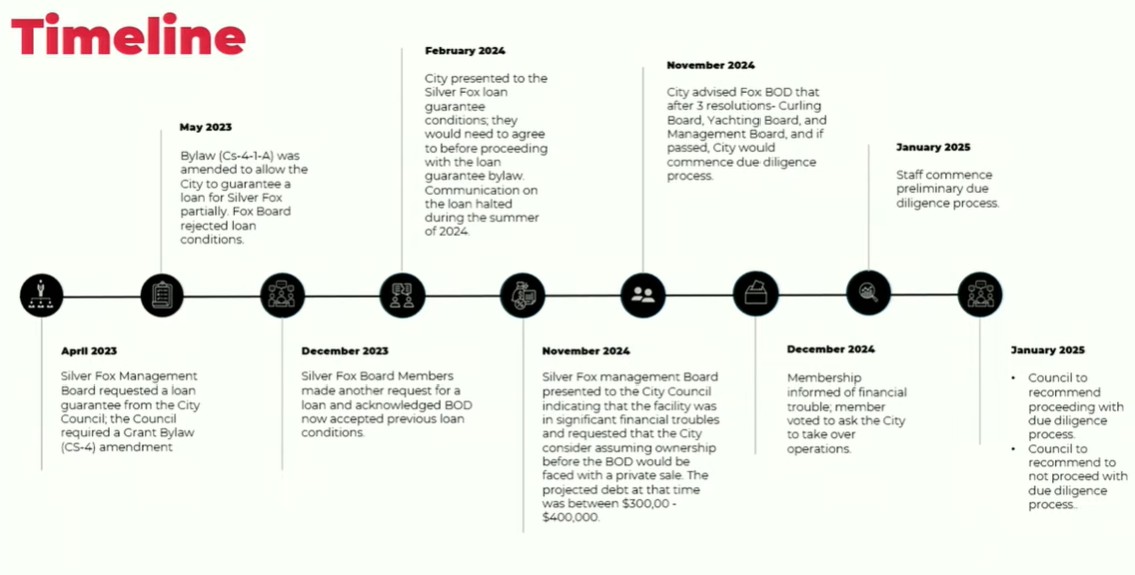 STAFF'S DUE DILIGENCE REPORT SUMMARY Below is a concise overview of the key findings from the City’s due diligence report on the Silver Fox Curling & Yacht Club (the report was included in the March Meeting Package):
Overall, the due diligence findings indicate that while there is a notable up-front financial commitment (including $525,000 in debt and some initial operating losses), the facility can be integrated into the City’s recreational portfolio with potential to reach near break-even by year three. The starting point, as one resident told me, is what happens if the City does not take over the assets and liabilities: “Please consider that if the city allows the silver fox to be sold to a private buyer, it is most likely that there will no longer be curling in this city. Curling is a winter sport that does not depend on snow or consistent temperature to operate. It is a sport that can be played by all ages. Historically, curling bonspiels have brought significant revenue to this city.” There were several distinct reasons that guided my decision:
With that being said, however, based on the staff's due diligence report, it is projected the Silver Fox would be breaking even or even working towards a small surplus in year three and beyond: § Year 1: $130,000 loss +$100,000 capital costs § Year 2: $50,000 loss § Year 3: $1,390 loss (break even) So, on the operational side of things, I believe a case has been made to support operating the Silver Fox as a municipality and not foresee undue financial hardship. And, after a time period has passed and if these projections are incorrect, the option to sell for a high rate of return could be put on the table.
To answer the question about the thought that curling is a "declining sport," I asked that we obtain membership data. The following chart is a combination of membership data supplied to staff and also my review of the Strategic Plan of the Curling Club:
Apart from the unique 2021–22 season—when the Crapaud Curling Club used Summerside’s facilities before returning to their own—membership trends at the Summerside Curling Club have held steady over the past seven years, without any significant decline. More encouragingly, since the introduction of the Club’s Strategic Plan, there has been a marked increase in participation from younger curlers. At the time of the Plan’s launch, 65% of the membership was aged 51 or older, whereas this year that figure has dropped to 30% (with 33% last year). This points to rising engagement among those under 50 and suggests continued growth now that the Club can devote more energy to membership development and curling programs, rather than simply keeping the lights on.
Some have questioned whether the City might be competing with local businesses—particularly bar and restaurant operations that are essential to supporting the facility. One resident put it this way:
It is important to clarify that the City does not plan to run the restaurant. Instead, the City will lease out the restaurant and create two separate entrances—one for the curling club and one for the dining establishment—so the restaurant can set its own hours and operate entirely independently. Far from competing, this arrangement is likely to boost private-sector enterprise by providing a prime location for a local operator to flourish. FINAL NOTE |
||||||||||||||||||||||
| Vote #15: Multi-year Funding Agreement Generation XX and BGC Prince County March 4, 2025 Meeting Package |
VOTED YES Resolution Carried 6-1 Meeting Video Table Summary of All Votes |
A resolution came to Council to approve a multi-year funding agreement between the City of Summerside, BGC Prince County, and Generation XX, running from April 1, 2025, to March 31, 2030, for a total of $250,000 ($50,000 annually, split equally between the two organizations). Under this agreement, each recipient will receive 90% of their annual allocation by April 30, with the remaining 10% disbursed upon submission of an annual report. The purpose is to ensure financial stability for BGC Prince County and Generation XX’s youth programs, foster collaborative efforts among community partners, and uphold standard reporting and communication protocols. Both organizations must acknowledge the City’s contribution publicly and permit City representatives to attend ticketed events. Amendments require written consent from all parties, and any party may terminate the agreement with sixty days’ notice. This document supersedes all previous arrangements and requires adherence to confidentiality and relevant legal requirements. Introduction to My Concern 1. The Community Support Policy
2. Letter Sent to Community Support Program Recipients
3. Comparison of the Letter and the Proposed Agreement
4. Potential Inequities With Other Organizations
5. Potential Review of Policy
6. “Good Faith” Clarification
Resolution and Final Vote
By integrating these clarifications, in my opinion, the agreement better aligns with existing policies while continuing to support valuable community programs in a manner that is equitable and transparent; however, I would consider a review of the policy as a moving forward action. |
|
| Vote #14: Acting CAO Appointment March 4, 2025 Meeting Package |
VOTED YES Resolution Carried 7-0 Meeting Video Table Summary of All Votes |
When a municipality faces a sudden or unexpected vacancy at the Chief Administrative Officer (CAO) level, as occurred in Summerside, appointing the Deputy CAO as Acting CAO during the transition to a permanent CAO is widely recognized as a best practice model. This approach ensures leadership continuity, project momentum, and organizational stability. Below is an overview of why this model is recommended, supported by references to local governance guidelines and recognized municipal management associations, and why I voted yes.
Conclusion
By following these established standards, Summerside can navigate pressing challenges securely and maintain public confidence in its municipal administration—and, in Council's only employee -- the CAO. |
|
| Vote #13: Climate Resilient Coastal Communities Program Participation February 19, 2025 (rescheduled from Feb 18) Meeting Package |
VOTED YES Resolution Carried 8-0 Meeting Video Table Summary of All Votes |
|
I voted yes to participate in the Climate Resilient Coastal Communities Program (CRCP) because of a number of reasons: 1. Investment in Long-Term Resilience
2. Access to Expert Technical Assistance and Training
3. Comprehensive and Integrated Planning Approach
4. Regional Collaboration and Shared Best Practices
5. Proactive Risk Mitigation
6. Alignment with National Priorities and Community Engagement
7. Alignment with City of Summerside Urban Core Plan (2016): Direct quotes from the Plan are as follows:
By voting yes on this (minimal) fee of $15,000 + tax, we’re not only investing in immediate technical assistance and planning support but also committing to a long-term vision that prioritizes sustainable growth, community safety, and proactive climate risk management. This forward-thinking approach is essential to ensuring that our coastal areas remain resilient in the face of evolving environmental challenges. |
|
| Vote #12: United States of America Trade Resolution February 4, 2025 Meeting Package |
VOTED YES Resolution Carried 8-0 Meeting Video Meeting Minutes Table Summary of All Votes |
|
Below is a summary of my rationale for voting yes on this resolution:
In summary, I voted yes on this resolution because it is a comprehensive approach to mitigating the risks posed by the possible U.S. tariffs, safeguarding our local economy, reinforcing national unity, and fostering a resilient and transparent economic environment. |
|
| Vote #11: Summerside Fire Hall Land Purchase February 4, 2025 Meeting Package |
VOTED YES Resolution Carried 8-0 Meeting Video Meeting Minutes Table Summary of All Votes |
|
I felt truly heartened to support relocating the Fire Hall to the new site on the East West Housing Corridor rather than at Leger Park. I wasn’t involved in the Leger Park selection process, and I completely understand the discomfort and concern many of you have felt about placing a critical service facility in a space that many hold dear. I believed there must be a location that not only meets our operational first response needs but also protects our cherished community spaces. The proposed corner of Ryan and MacEwen on the EWHC is just as strategically placed to serve the center of our 8‑km service area, ensuring rapid emergency response while preserving the beauty and function of Leger Park. We all deserve to feel safe and secure, but it’s equally important that we safeguard the parks where our children play, where our seniors enjoy quiet afternoons, and where our families come together. I voted yes because I genuinely believe that this new location respects both our need for efficient fire safety and the vital greenspace that makes our city such a wonderful place to live, work, and play. BACKGROUND Before diving into the discussion, it’s important to share some context. During my door-to-door conversations in October 2024, many community members expressed significant concerns and misunderstandings about the Fire Hall’s proposed location. I genuinely empathize with these worries and had the same misunderstandings. I believe a new Fire Hall should serve as a beacon of unity and celebration, reflecting our community’s commitment to safety and togetherness. Unfortunately, the lack of clear communication from the city had only fueled confusion and concern for many residents. Land Acquisition and Early Announcements
Community Engagement and Miscommunication
Recent Developments and Official Announcements
Community Impact and Concerns for Leger Park Following the Dec 2024 announcement of Leger Park, the only responses from the public on the Leger Park location were negative – not one member of public shared with me their support of this location. The four key concerns with Leger Park are as follows:
I agree that the first three key areas of concern residents have expressed to me align with my thoughts and beliefs if Leger Park were to be chosen. I believe the plan to safeguard the area with a fence around the property would negate the safety concerns. Community Impact and Concerns for New Location While the community feedback for the new EWHC location was substantially more in favour of this location, there were concerns raised about the EWHC location. Here are the concerns and my response to these concerns:
In short, for the majority, even those who identified concerns, they stated that they would support the EWHC as a better solution than Leger Park. Fiscal Considerations
§ 38% of this cost is allocated to the utilities, with $1.5 million being paid from the General Fund. § Paying off this 30 million dollar loan will not “open” up $2.4 million in spending for the general fund. § We are purposefully timing debt for the fire hall to come online after Credit Union Place has been paid off, knowing that Credit Union Place will have some significant capital costs that will be necessary.
o City plans to apply to the FCM Green Municipal Fund for a loan plus grant. Currently, the program is under review so we have not submitted the preapplication form yet (to determine if our project is eligible) plus we do not have final costs/timeframes nailed down yet which may be required to submit the preapplication and application forms. o How it works: § The loan can be for up to 80% of eligible costs + grant to a maximum of $10M. § The grant is up to 15% of the loan. § If we were eligible for the full $10 million then we would get a loan for $10M and a grant of $1.5M. Depending on the interest rate at the time at the end of the day the grant may cover your interest costs so essentially it would be a no (or at least a low) interest loan. § Based on the estimates we expect that we would hit the maximum of $10M loan + $1.5 grant
Conclusion The controversy surrounding the Fire Hall location is multifaceted—combining issues of transparency, community impact, fiscal responsibility, and the fact I came in on this process at the tail end. While the initial plan for a site between the strip mall and the Cineplex was widely publicized, subsequent developments and decisions were made behind closed doors and miscommunications had sown confusion. In my view, the process should have been far more transparent, particularly given the significant community value of Leger Park, and specifically because Council would still need to vote on the rezoning and any Councillor whom already had their mind made up would be deemed to be in a conflict of interest. I’ll end my rationale by stating that a new Fire Hall should be a moment for community celebration, not a source of contention or a reminder of lost greenspace. By voting yes on the EWHC location, I hope the legacy of the new location will be the legacy of community pride. |
|
| Vote #10: $11.9M in Long Term Borrowing February 4, 2025 Meeting Package |
VOTED YES Resolution Carried 8-0 Meeting Video Meeting Minutes Table Summary of All Votes |
|
I supported the resolution because it provides the City of Summerside with essential funding—through approximately $11.9 million in borrowing—to finance capital projects ($11.5M for Eco Park Building, $3.8M Water utility, $3.4M Sewer Utility, $291K Fire Hall pre-design, $27.5K Land Purchase) and refinance maturing loans ($396,200 for water and sewer reconstruction), all while staying within the debt limits set by the Municipal Government Act. The recommendation from the Finance Committee and the secured borrowing process gave me confidence that this step was necessary for maintaining our infrastructure. However, I remain deeply concerned about our long-term fiscal trajectory. Our consolidated financial statements reveal that our long-term debt has surged from $14 million in 2002 to $74 million in 2023‑24, and debt servicing now consumes 18% of our total expenses (over $5 million per year). This trend underscores the urgent need for a comprehensive plan aimed at reducing our debt servicing costs over time to ensure sustainable financial management for the future. |
|
| Vote #9: 255 Greenwood Drive (R1,R2 to R4) February 4, 2025 Meeting Package |
VOTED NO Resolutions Defeated 5-3, 6-2 Meeting Video Meeting Minutes Table Summary of All Votes |
|||||||||||||||
| To begin, please follow this link to best understand the factors I consider when making a decision on rezoning land to R4. Making a land use decision to rezone to R4 cannot be made lightly and must consider a number of factors. The above link gives the public insight into my decision-making process. INTRODUCTION An application from Z & C Flourish International Ltd. for three different portions of PIDs to amend from Low Density Residential R1 or R2 into High Density Residential R4. Of the 64.4 acres the developer owns, they wanted to rezone 15.2 acres (24% of the land) to R4. The zoning for the middle section of the development will remain as is and will be developed as per the uses permitted in the current zones. For reference, please see the Development Concept presented submitted by the Developer: PROCESS:
MY DECISION: The proposed residential land use aligns with the Official Plan, subject to Council’s relevant policies regarding high-density housing. In particular, the Official Plan identifies three key location criteria for high-density development (see pages 86–87):
Furthermore, this development aligns with a core Official Plan objective found on page 87: “to encourage high-density housing,” which includes accommodating applications for higher-density residential development and supporting rezonings in suitable areas. Notably, the Official Plan was updated, effective January 23, 2025, to broaden its objective from “to encourage high-density housing in specific areas” to a more general “to encourage high-density housing” everywhere. It is important to note, however, that Council’s decision on whether to rezone the subject property to R4 cannot be based solely on the location criteria for high-density housing (pages 86–87) or the Official Plan’s stated intent to encourage such development. There are numerous other considerations within the Official Plan that must be evaluated to determine whether this project fully conforms to its policies and objectives. I voted no on this application because it does not align with the Official Plan’s emphasis on housing diversity, from the Council’s policy to “promote a range of housing types and forms to accommodate a mix of age and income groups” (p. 46) to its overall vision for “a broader mix of housing and affordability choices” (p. 39). The Plan highlights the importance of creating inclusive neighborhoods by encouraging “a range of housing types and tenures” (Neighbourhoods Strategy, p. 54) and supporting “other housing alternatives” (p. 49), such as conversions, accessory dwelling units, and adaptive conservation of heritage houses. It further stresses “a range of housing types, densities, and forms of tenure” (p. 79) and specifically encourages smaller-scale multi-unit forms like semidetached houses, fourplexes, and row houses (p. 81). The City’s commitment to implement the Mayor’s Task Force on Attainable Housing (p. 14) reinforces the need for a balanced mix of housing types, noting that “a one-size-fits-all approach will often mean that current needs aren’t met” (p. 15) and recommending “a broader range and mix of dwelling types” (p. 16). Considering that Summerside has already seen 22 apartment complexes constructed or underway since 2022, approving yet another seven high-density buildings—potentially 11 in total—does not address these Official Plan directives or Task Force recommendations. Instead, it merely adds more apartment units without meeting the identified need for missing middle housing, which is why I could not support this proposal. The Official Plan stresses the need to develop “missing middle” housing—which lies between single-family homes and larger apartment complexes—throughout the City’s 600 hectares of vacant, residentially designated land (p. 84). It specifically encourages housing forms such as duplexes, fourplexes, smaller multi-unit buildings, row houses, and townhouses, all of which fit better into existing neighborhoods, support walkability, and align with local retail and transit opportunities (pp. 47, 84). Additionally, the City’s Housing Accelerator Fund provides financial incentives for creating or redeveloping lots capable of supporting missing middle housing, as well as for adopting design requirements that facilitate this type of development. Since 2022, however, 22 new apartment buildings have been built or are under construction—686 units—none of which address the missing middle gap. Proposing seven to eleven more high-density apartment buildings without meaningfully addressing the missing middle housing shortfall identified in the Official Plan led to a “no” vote, based on the concern that additional apartments do not fulfill the City's call to increase middle missing housing. Summary of Official Plan Guidance on Affordable Housing and Its Relevance to the Application The Official Plan’s primary vision is to create a “Livable Community” (p. 40), defined as an attractive, accessible city that meets the needs of a diverse population with quality, affordable housing, efficient transportation, and a strong economy. The Plan’s Overall Vision Goals emphasize increasing density to prevent sprawl, offering a broader mix of housing and affordability choices (p. 39), and continually promoting inclusive growth that ensures “quality housing for all household types, age groups, and income levels” (p. 42). To accomplish these objectives, Council has introduced multiple policies, including density bonusing to support the construction of affordable units (p. 82) and initiatives such as the Housing Accelerator Fund, which provides financial incentives for projects that specifically address housing for vulnerable populations or create affordable home options. The Plan also calls for ongoing monitoring and evaluation of the City’s housing supply to ensure affordability, diversity, and accessibility (p. 48, 79, 87). Further reinforcing these principles, the Mayor’s Task Force on Attainable Housing highlights that “housing should be available for all household types, life stages, and income groups” (p. 18), and calls for targeted solutions rather than a one-size-fits-all approach. When considering whether this application helps to ensure housing affordability, the Official Plan cautions that simply increasing the number of units may not, on its own, address affordability issues in the near term [see my note beginning with "Really" in the next paragraph]. Instead, the Plan directs Council to pursue deliberate strategies—like requiring or incentivizing affordable units within new developments—to ensure the community’s housing needs are actually met. During the presentation for this proposal, there was no indication that these units would be offered at affordable rates or otherwise contribute to the City’s stated affordable housing goals.
These directives, taken together, illustrate the Official Plan’s broader stance that supply alone does not necessarily solve affordability issues—hence the paraphrase I inserted. Environmental Review of Watercourse/Wetland Area The application under review includes steps to mitigate potential environmental impacts. City staff have specified the following requirements:
While these conditions would typically come into play during the Site Plan approval stage (read: not necessary at this point), this application has been before Council once already (in June 2023), with the same directive for an environmental review. Consequently, it would have been prudent for the applicant to proactively engage with the Department of Environment in advance of returning to Council. Moreover, the proposed development sits adjacent to two designated greenspaces and intersects a planned greenspace trail. This adds another layer of environmental and planning considerations. If Council approves the rezoning based on the current concept plan and the Department of Environment subsequently raises concerns about encroaching on greenspace, the rezoning would stand, but the applicant would need to revise the concept plan. Although a concept plan can be altered at any time, establishing the viability of the proposed development at this stage is important for me. It also demonstrates that the applicant has undertaken due diligence, which in turn provides more clarity and confidence for both Council and the public. If I were in the developer’s position, having had an earlier application denied, I would have sought preliminary discussions with the Department of Environment to ensure that the proposed concept aligns with environmental regulations from the outset. Presenting these findings to Council would have underscored the project’s feasibility and addressed potential concerns before the matter reached the rezoning stage again. Careful Consideration of Existing R4 Land Supply and Future Growth In evaluating new applications for high-density zoning (R4), it is critical to consider the existing supply of R4-designated land and other key factors:
Given the addition of over 600 apartment units since 2022, the forthcoming 2,000 EWHC units, and the high-density potential of existing R4-zoned lands, the City should proceed judiciously with further rezoning to R4. This approach aligns with the Official Plan’s Overall Vision—which emphasizes creating a “Livable Community” by balancing density, affordability, and efficient land use by offering "a broader mix of housing and affordability choices” (p. 39)—and ensures that rezoning decisions support the Plan’s longer-term goals rather than simply increasing the supply of high-density units without comprehensive planning. I would be remiss if I did not include my thoughts on the presentation by the applicant as pat of my decision-making process. During the developer’s presentation on December 16, 2024, Public Meeting (Video: starts at the 1:07:00 mark ) to Council, I was concerned that Council did not walk away from the presentation fully understanding the basic details of the development. For example, even as two different Councillors asked about the number of apartment buildings or the number of units per apartment building, there were no details provided other than the development would not be five or six storeys tall and that “did not want to throw something together quickly . . . it will take some careful study.” In my mind, and specifically because a similar application came before Council in June 2023, I would have expected the developer to be able to answer the basic questions of (1) how many apartment buildings, (2) how many units per building. The applicant had 16 months to come back and be prepared. |
||||||||||||||||
|
Vote #8: Temporary Increase in Operating Line of Credit from $5M to $10M until March 31, 2025 |
VOTED YES |
|
I voted yes on this item because it ensures the City of Summerside has the financial flexibility to meet its obligations while waiting for anticipated funding. The expenditures for critical infrastructure projects—such as the east-west corridor, the eco-park building, and water and sewer reconstruction—have already been covered by our general operating account. This temporary increase to the operating line of credit serves as a safeguard, ensuring that the city can continue operating smoothly if there are any delays in receiving the expected funding from programs like the Housing Accelerator Fund and the Canada Community Building Fund. Per section 166 (1) of the Municipal Government Act Part 6, Division 3, "a council may be bylaw authorize the borrowing of money on a short-term basis for the purpose of financing operating expenditures." |
|
|
Vote #7: Twinning City with Kremenents, Ukraine |
VOTED YES |
| I voted yes on the resolution to pursue a twinning city agreement between the City of Summerside and Kremenents, Ukraine, as it offers a unique opportunity to foster international collaboration and goodwill. Establishing a twin city relationship will promote cultural exchange, increase mutual understanding, and create opportunities for shared learning between our communities. Furthermore, this agreement can help provide vital support to Kremenents during difficult times, demonstrating solidarity and compassion. Through this partnership, Summerside can play a role in global efforts for peace and community development while enriching our local culture and international outlook. | |
|
Vote #6: Multi-year Funding Agreement |
VOTED YES Resolution Carried 8-0 Meeting Video Table Summary of All Votes |
|
I supported the 5-year funding agreement with the College of Piping and Harbourfront Theatre because it aligns with the goals of fostering community enrichment, promoting cultural heritage, and ensuring the sustainability of two key non-profit organizations in Summerside. This agreement, which provides $90,000 annually to each organization, represents a modest increase from previous funding levels ($87,000) and demonstrates Council’s commitment to supporting institutions that enhance our community’s cultural and artistic fabric. Enhancing Community and Economic Benefits Conclusion |
|
|
Vote #5: Repeal of Taxi Bylaw |
VOTED NO Resolution Carried 7-1 Meeting Video Table Summary of All Votes |
|
The City of Summerside Bylaws & Governance Committee considered whether the current Taxi Bylaw offered any tangible additional protection beyond what is already provided through provincial legislation, and recommended repealing the Taxi Bylaw with “[t]he belief there will be little to no impact on either the businesses or the clientele they serve.” (Click and enlarge the discussion points from the Committee’s Recommendations.) While I value the committee's work, I disagree with its findings: I believe the regulatory powers in the city’s taxi bylaw do offer additional protection not already provided through provincial legislation in three key areas. 1. Criminal Record Checks First, The Taxi Bylaw requires all persons wishing to have a taxi operator licence to pass a Criminal Record Check. There is no provincial regulation of the taxi industry in PEI. Repealing this taxi bylaw places people using a taxi service in Summerside at a greater risk of potential harm than someone using a taxi service in Charlottetown. For example, in Charlottetown, a person convicted of an indictable offence or a summary offence is not eligible to drive a taxi based on the number of years since the offence; however, if repealed, that same person could become a taxi operator in Summerside. So, a person who has been convicted of sexual assault or impaired driving would be eligible to operate a taxi as long as they are allowed to drive a vehicle. I had tabled a report from the Provincial Advisory Council on the Status of Women of NF during the previous Committee of the Whole meeting (report begins on Page 6) that highlighted 8 key recommended actions, criminal and vulnerable sector record checks among those recommendations. I believe removing the current protection of criminal record checks from those applying to be a taxi operator. or the ability for the Chief of Police to suspend a license for good reason (say, convicted of an offense after obtaining a taxi operator license), does put the public at a potential greater risk. 2. Insurance The second protection our taxi bylaw provides is insurance. The Committee’s Report states that all registered motor vehicle owners require $2M third-party liability insurance, but in my research, I found evidence that says otherwise.
In short, my research shows that $200,000 is the minimum required by provincial law for third-party liability insurance coverage, while insurance companies typically recommend $1M or more. So, the $2M required by the Taxi Bylaw is, in fact, added protection from the $200,000 required by provincial legislation. 3. Maximum Fares The final (and third) protection provided by the taxi bylaw that is not provided by provincial legislation is setting maximum fares. So, if the taxi bylaw is repealed, the city will no longer regulate maximum taxi fares. Those who typically access taxis are those without access to their own motor vehicle transportation: seniors, low income, and people with disabilities who cannot or will never be able to drive themselves. In my research, taxi bylaws are sometimes criticized because they determine the cost of fares, which leaves taxi owners at a disadvantage (not able to lower fares to that of ride share companies); however, setting only the maximum rate, I view our current taxi bylaw as offering the financial protection of the users of the taxis, and regulating the posting of fares in the taxi cab ensures fairness, equality, and non-discriminatory rates. Municipal Governance Act In conclusion, I end with section 3 (d) of the Municipal Governance Act, which states that one of the purposes of City Council is to “develop and maintain the municipality as a safe and viable community.” Here is the complete section within the Act:
A safe community is one that actively works to prevent crime and reduce harm by implementing a variety of protective measures and proactive strategies. If we repeal the taxi bylaw, consequently eliminating any criminal record check from the taxi operator application process, we are removing a public protection currently in place in the city. So -- in my thinking -- I cannot reconcile how removing a current public protection aligns with the purposes of City Council as per the MGA to "develop and maintain" the city as a safe community. In fact, the removal of legislated public protection is to lessen the current safety protections within the city. |
|
|
Vote #4: Island-Wide Public Transit Governance Framework |
VOTED YES Resolution Carried 8-0 Meeting Video Table Summary of All Votes |
|
I voted YES for that "Council direct staff to engage with their provincial counterparts to explore options for a province-wide transit governance framework" based on the following rationale: Supporting Vulnerable Populations Public transit is a lifeline for many vulnerable populations, including seniors, people with disabilities, low-income residents, students, and those who cannot or choose not to drive. These groups often face barriers to mobility, such as limited access to affordable transportation or the inability to navigate car-dependent infrastructure. A strong, accessible transit system ensures that these individuals can reach essential services like healthcare, education, and employment opportunities, fostering greater independence and quality of life. For example, seniors can maintain their connection to the community, and students can travel to schools and jobs without relying on family or friends for rides. Investing in transit is a step toward creating a more equitable and inclusive province. Supports a Greener Community Prince Edward Island is one of the most car-dependent provinces in Canada, with 92% of Islanders relying on cars for daily transportation. In Summerside, 93% of residents drive or are passengers to work, while 7% use AT, transit or other methods (Census 2021). As 72% of residents live and work in the city, the average commute is 13 minutes. This level of car dependency poses significant challenges, including high greenhouse gas emissions, limited mobility for those without access to a car, and inefficiencies in how people travel within and between communities. The proposed transit initiative represents a transformative step toward addressing these issues by creating a well-planned, province-wide framework that prioritizes accessibility, sustainability, and efficiency. Importantly, this initiative keeps decision-making power in the hands of municipalities, ensuring local input and control over transit operations while benefiting from streamlined administration and funding opportunities. By voting yes, I support a vision to reduce our reliance on cars while improving transportation options for all Islanders. Province-Wide Transit Governance Framework: The 6 Key Principles (as presented on Dec 3, 2024 Committee of the Whole, and written below based on my understanding)
Conclusion This initiative benefits not just Summerside but all of PEI. It creates a transit framework that supports vulnerable populations, connects communities, and provides an environmentally friendly alternative to car dependency. I view a yes vote as a crucial step toward a more accessible, equitable, and sustainable future for everyone on Prince Edward Island, and residents of Summerside. |
|
|
Vote #3: Mobile Sales Unit on Milton Ave |
Voted NO |
|
Fact: a mobile sales unit was approved in a residential property 6 months ago (480 Central on April 2024). Page 26 of the Guide to the Municipal Government Act Handbook addresses an important issue on this file: "Citizens expect that people in similar situations will be treated similarly. If someone is treated differently, it should be because their circumstances are different." So, let's first determine if this case is different or similar? If the circumstances are not different, then the application should be approved based on "people in similar situations will be treated similarly". The April 2024 approval was on an R4 property, and it's abutting a Commercial property to its south and the largest series of Commercial-zone properties in the city on its east. By contrast, the Milton Ave property is an R3 surrounded by pretty tight R3 properties. I based my vote on the fact that the individual circumstances were significantly different, and thus why one residential property was approved for a mobile sales unit in April 2024, and this second residential property received my NO vote. Of interest, there is no policy requiring the city send a letter to nearby residences when an application is received under the Licensing Bylaw CS-21. I believe we need to revisit this policy. |
|
|
Vote #2: Greenwood Drive Official Plan amendment |
Voted NO |
|
I based my NO vote on the following information: (1) Since 1998, 25 acres of industrial land (lost 30 but gained 5 acres) have been lost in the city. As Mike Thususka, Director of Economic Development, referenced generally in a letter dated Sep 30, 2024, industrial land's role in the city must be considered as "employment lands" as these lands are essential for supporting employment and employment growth. If we lose more industrial land, we need to seek other areas in the city to replace what has been lost. |
|
|
Vote #1: Official Plan and Zoning Bylaw Amendments Housing Accelerator Fund |
Voted YES |
|
Follow this link for details on my decision-making. Summary: I was voting NO on this Resolution at the morning of the vote, but after residents of Evergreen Village reached out to me (57 homes on the verge of being evicted), I looked at the plan in more detail and how it could help people who are struggling to find a home or displaced from their homes and the death of someone who, if they had supportive housing, there was a good chance they would still be alive . . . In fact, I could not shake the images of going door to door and witnessing first-hand so many people living with various forms of hardship. All of these hardships had one central theme: unsuitable or unaffordable housing. Lastly, when that person died who I believe would still be alive with suitable housing and I cried in the hospital's lobby, I vowed to make the hard decisions and to do whatever I could to bring more affordable, suitable, and supportive housing to the people who desperately need it in this city. I just never expected the hard decisions to be this hard. And to come so quickly in my term. I can see both sides of the issue, but if a yes vote could accelerate affordable and suitable housing, save a life, issues that are the core of who I am as a human . . . and as I examined the details more, incentives in the plan for people to build: - 15 Accessory Dwelling Units over 3 years It really sounds like it could help. It certainly sounds like a starting point. |
|


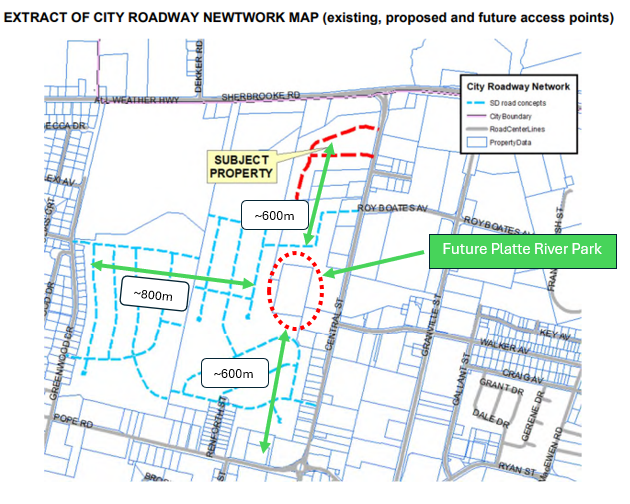

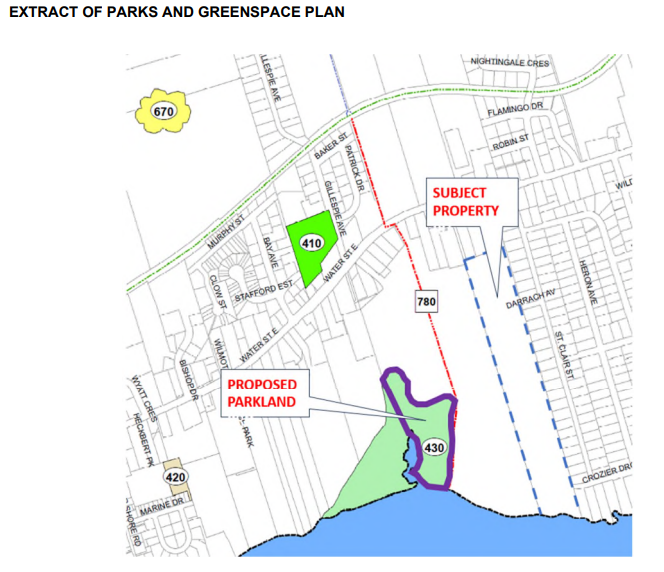 While the proposed conservation land (#430 on the Parks and Greenspace Plan) has been presented as parkland dedication, I see value when a development plan is presented on the abutting PID# 72421 (which is all R4) to examine if this area should have a playground. The image below illustrates the distance from the proposed development and the metres to the nearby parks. With R4 land surrounding this area, it would be great to have a playground that children could access "in their backyard" and not have to cross busy Water Street East.
While the proposed conservation land (#430 on the Parks and Greenspace Plan) has been presented as parkland dedication, I see value when a development plan is presented on the abutting PID# 72421 (which is all R4) to examine if this area should have a playground. The image below illustrates the distance from the proposed development and the metres to the nearby parks. With R4 land surrounding this area, it would be great to have a playground that children could access "in their backyard" and not have to cross busy Water Street East. 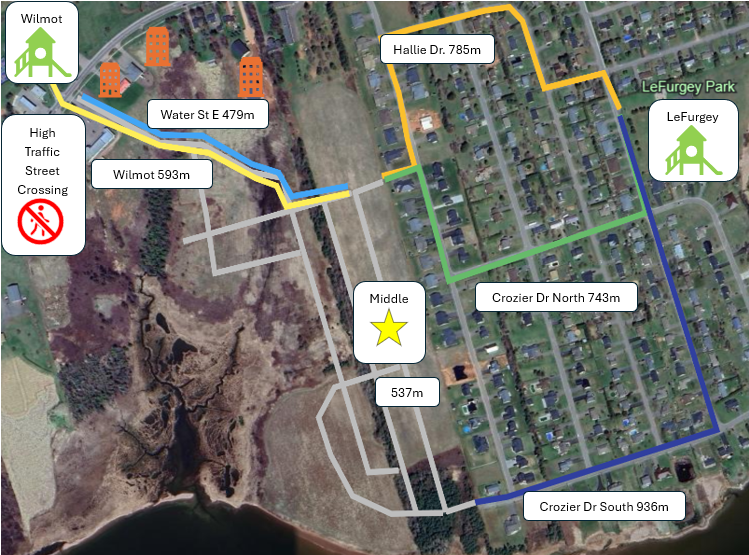
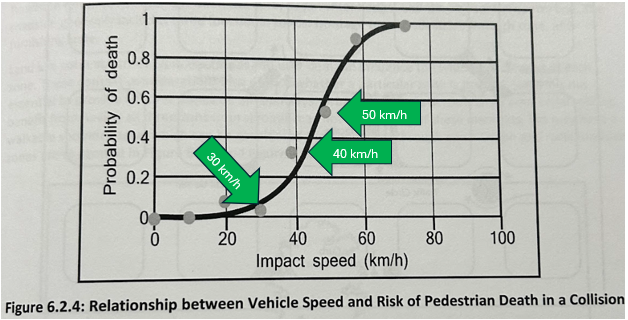






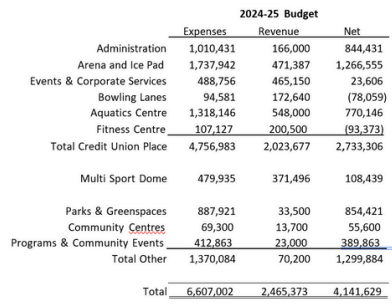
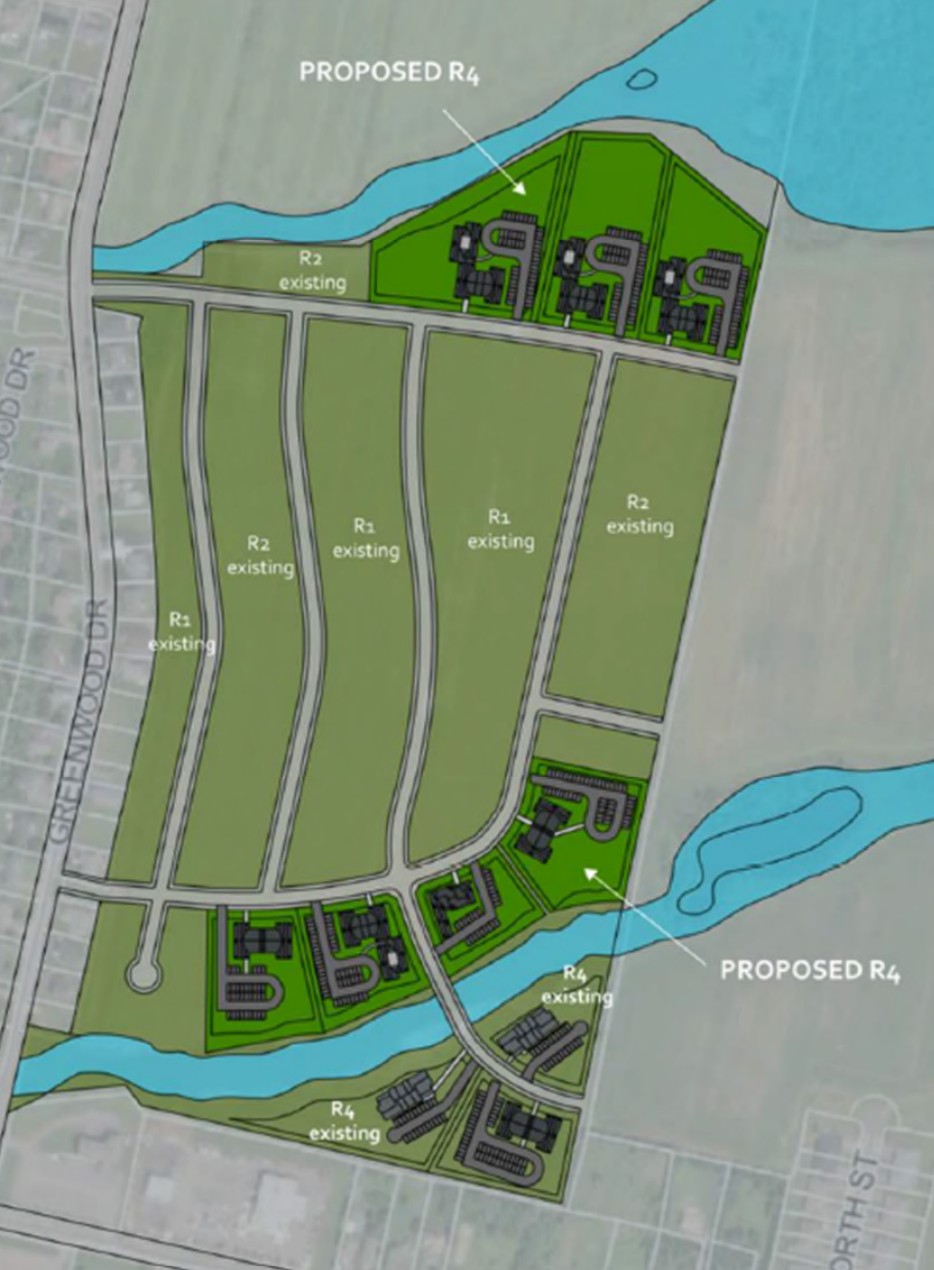
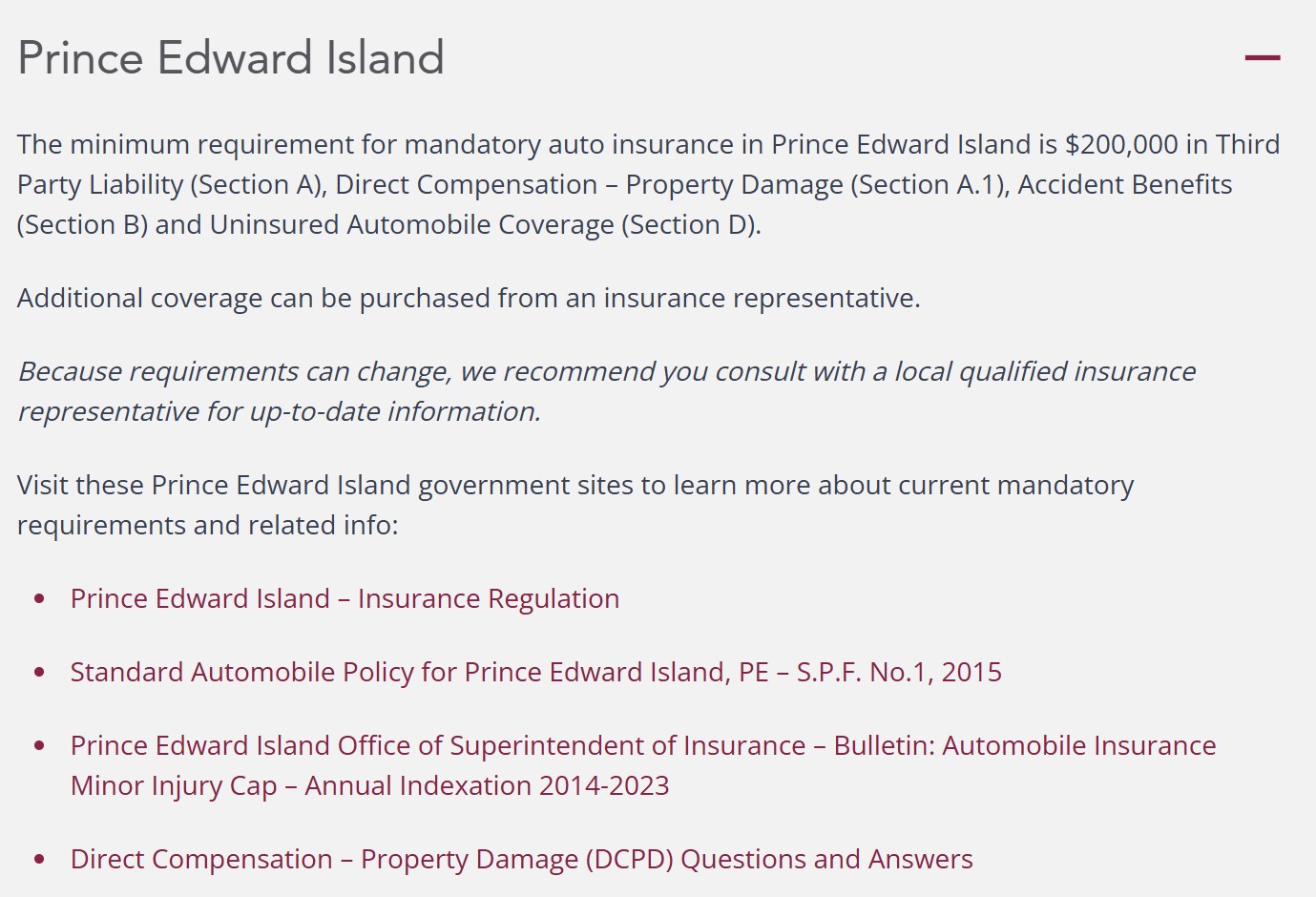
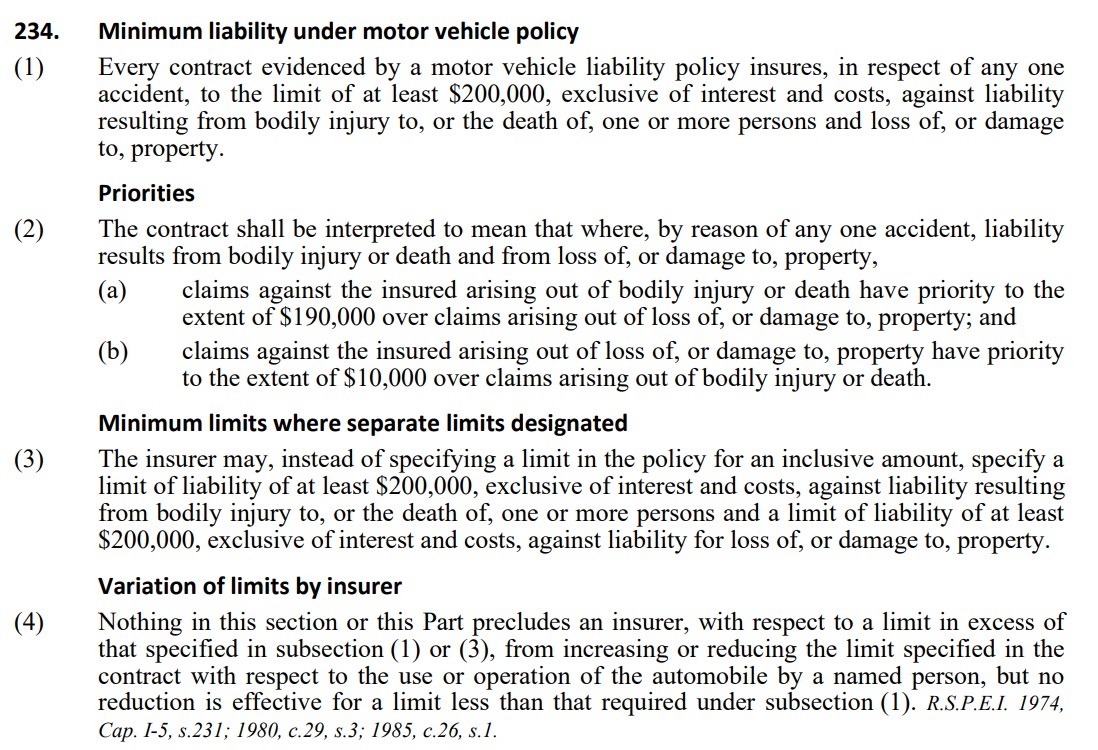

 An application was received under Section 3 of the
An application was received under Section 3 of the 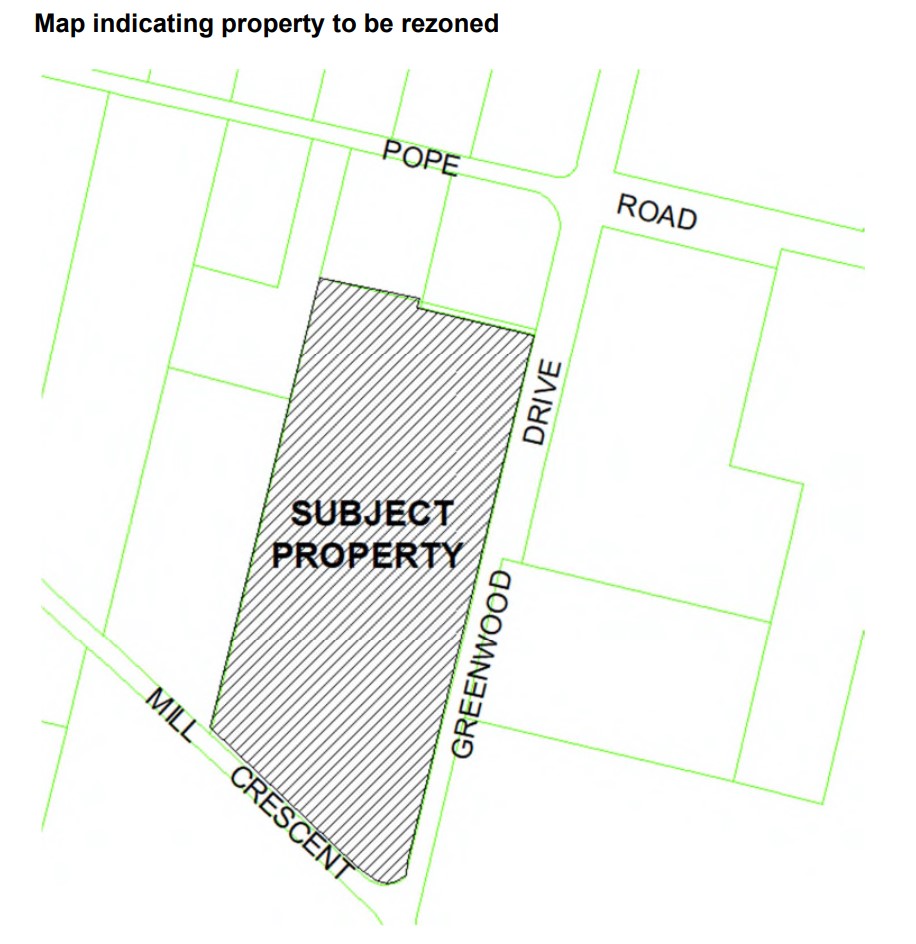 An application was received regarding PID #308593 to amend the Official Plan land use from Industrial to Residential and the zoning from Light Industrial (M1) to High-Density Residential (R4) zone. The purpose of the amendments was to allow apartment building development (3 -24 unit buildings) in the proposed R4 zone.
An application was received regarding PID #308593 to amend the Official Plan land use from Industrial to Residential and the zoning from Light Industrial (M1) to High-Density Residential (R4) zone. The purpose of the amendments was to allow apartment building development (3 -24 unit buildings) in the proposed R4 zone.
